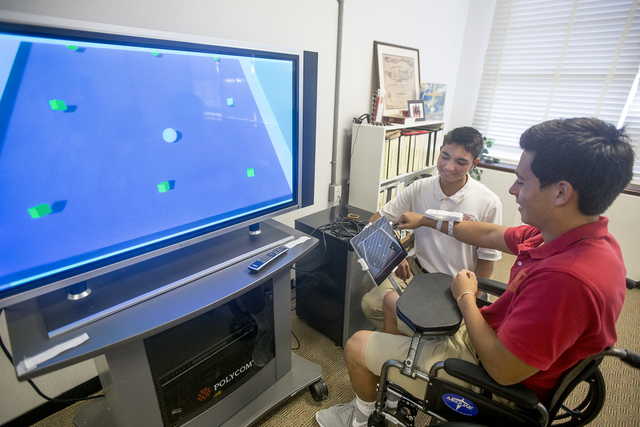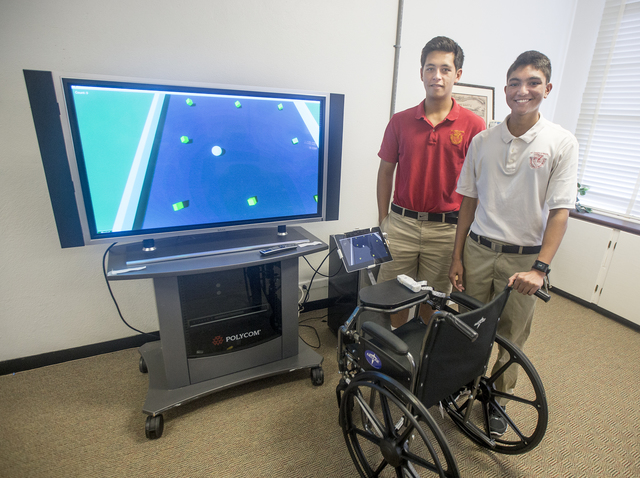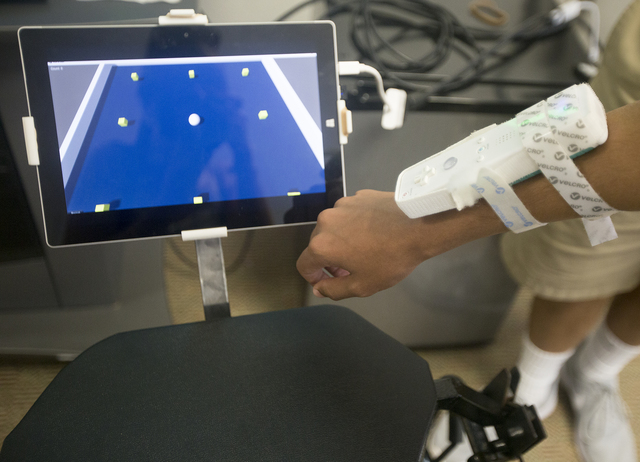It started as a problem. Statistics show elderly people who are wheelchair bound generally don’t get enough exercise.
So St. Joseph School seniors Cole DeSilva and Jonathan Ulhmann, under the guidance of independent studies science teacher Matt Eftink, spent the past school year putting together a gadget that could help.
“We knew there was this problem with the elders in Hawaii,” DeSilva said. “And we (had to figure out), what can we do to help them?”
The students, both 17, built what they call a wheelchair device — essentially a game programmed to a Wii remote, which allows an elderly person to safely exercise in their chair. The students used nearly $4,000 in grant funding from the Hawaii Community Foundation “THINK Fund” to purchase supplies including a wheelchair, a 3-D printer, a tablet and Wii remotes and completed the gadget as their senior project, a graduation requirement for all St. Joseph seniors.
Last week, they presented their project at school and on April 30, they presented at AstroDay at Hilo’s Prince Kuhio Plaza.
The device is simply a prototype, yet both DeSilva and Ulhmann say there’s potential for the concept to be further honed and eventually, fill a growing market in senior care.
“We feel like it’s a pretty good idea,” DeSilva said. “Not necessarily just for the wheelchair (part of it), but kind of the whole idea of the mobile health industry is really growing. And I think the elders could really benefit from having this kind of help.”
To use the device, a wheelchair bound user plays a computer game which requires either arm or leg movement. For example, one could play a football video game where they would need to move their legs, to “kick” the football. Motion from the “kick” is transferred to the computer via a Wii remote, which is attached the user’s arm or leg.
DeSilva and Ulhmann downloaded a game template off the Internet and conducted hours of coding to modify the games for their project. They created niche parts using the 3-D printer, and specially programmed Wii remotes — which have accelerometers built into them — to use as motion tracking devices. Remotes can collect data, to potentially be used by doctors and other medical specialists. And the game, the students say, makes exercising just a bit more fun.
“To me, a game brings happiness,” Ulhmann said. “By playing a game, they’ll be less depressed. This is also for the mind, not just the body.”
Data shows disabled people do not get enough exercise. One 2014 report claims around 57 percent of people in the United States with limited mobility don’t exercise at all. Research shows a lack of aerobic activity can contribute to health issues such as cancer, diabetes and heart problems.
For seniors, preventative maintenance is even more important, research shows. One study claims one-third of people age 65 and over fall each year, which increases with age — by age 80, more than half of seniors fall each year and falling once increases the risk of falling again and lowers chances of recovery.
“The interesting thing is, that entire space in senior care is going to boom over the next 20 years,” Eftink said, adding his own mother-in-law tested the device. “It’s ‘How to keep seniors mobile, cut costs and medical expenses.’ That’s going to be a huge area.”
Ulhmann plans to attend the University of Illinois at Chicago next year to study computer science. DeSilva plans to attend Gonzaga University in Spokane, Wash., and is mulling pre-med or computer science studies.
The Hawaii Community Foundation grant was hoped to be part of a multi-year project aimed at giving kids opportunities to help the community, Eftink said. The project no longer exists, he said, but ideally, he’d like to continue honing the wheelchair device.
“We’ve got another group of kids who’d love to finish this project up, go into the senior care homes and have (seniors) use it,” Eftink said. “In a real project, that’s the next phase — proof of concept to field testing. I have kids who’d like to do that, but I don’t have any grants or funds to follow.
“This was really unusual for a senior project,” he continued. “We may not get a chance like this again.”
Email Kirsten Johnson at kjohnson@hawaiitribune
-herald.com











